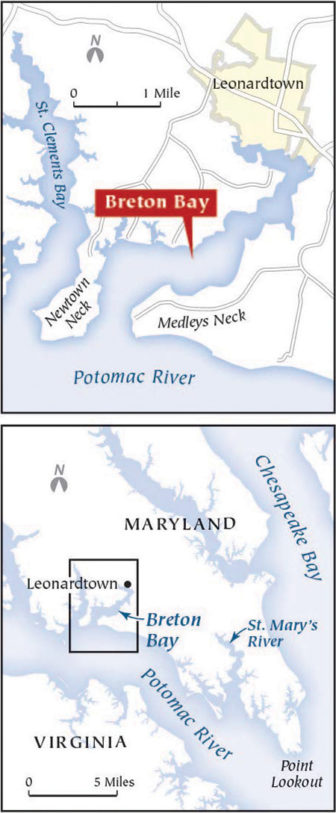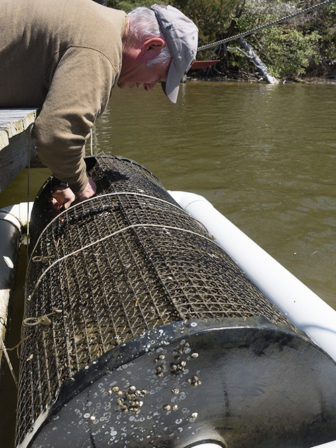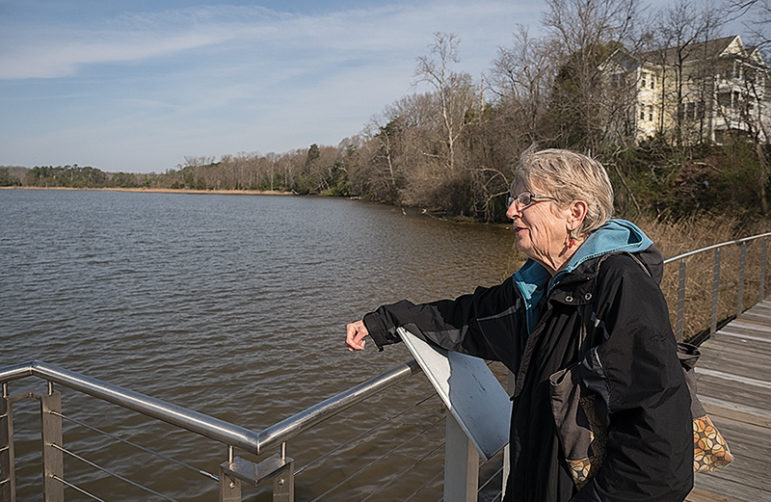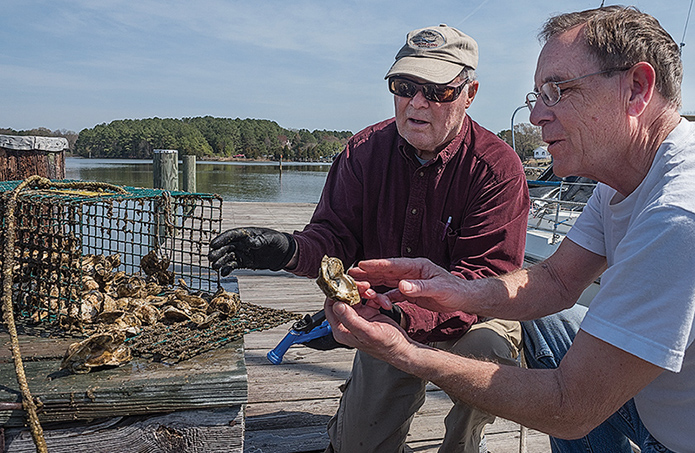By Timothy B. Wheeler
Bay Journal

Lucidity Information Design
Nearly 60 years ago, the oysters in Maryland’s Breton Bay were so plentiful that you had to be careful where you set foot on the bottom. Chuck Bright, who spent his summers there in those days, learned that the hard way.
“I jumped off the pier and sliced my foot on an oyster shell,” said Bright, 68, a dentist who now lives year-round in the waterfront home his father built there in the 1950s.
As in so many other places around the Chesapeake Bay, oysters are now scarce in Breton Bay, a short, relatively wide tributary of the Potomac River that zigzags south like a question mark from Leonardtown, MD.
But the bivalves may return to this picturesque and comparatively remote estuary if a proposal by the Maryland Department of Natural Resources comes to fruition. State officials have nominated Breton for an ambitious effort to restore its long-dormant oyster reefs.
DNR Secretary Mark Belton announced in December that he’d picked two Potomac River tributaries — Breton Bay and the nearby upper St. Mary’s River — as the fourth and fifth Chesapeake tributaries where Maryland would work with federal agencies to try to revive depleted oyster populations. Both are in St. Mary’s County, across the Chesapeake from three waterways already undergoing restoration — Harris Creek and the Tred Avon and Little Choptank rivers.
Caught off guard
Belton’s announcement caught locals off guard. Few thought Breton Bay stood much of a chance among the 12 rivers and embayments under consideration for the final two large-scale oyster restoration projects. And its selection drew criticism from some scientists and environmentalists, who questioned whether Breton was a good candidate for such an effort.
But the choice of Breton Bay has galvanized the leaders of the fledgling Friends of St. Clements Bay, which formed last year to grow oysters and clean up a trio of watersheds off the Potomac in St. Mary’s County, including Breton Bay. St. Clements Bay is Breton Bay’s less curvy twin, flowing into the Potomac less than a mile to the west.
“We really think it’s got tons of potential,” said Liz Curtz, one of the group’s founders. “It was a great oyster bed and pretty much collapsed at the end of the last century. We think it is very exciting to think about it coming back.”
They aren’t waiting around for the government, either. Curtz said the group recruited 39 waterfront property owners last fall to raise about 90 cages of oysters by their docks, 22 of them in Breton Bay.
Won’t be easy
Bringing back Breton’s oysters won’t be easy, though. Like the oyster populations in the rest of the Chesapeake Bay, Breton’s dwindled through overfishing, pollution and disease. The diseases have abated there, as they have throughout the Chesapeake, and there’s been no commercial harvest since 2010, when the state made it a sanctuary. It’s not clear, though, how many oysters are left.
Now, the question is whether the water quality has improved, and whether there is enough hard bottom left for oysters to sustain themselves if planted there. Unless there are affirmative answers to those issues, Breton won’t be eligible for federally funded reef restoration by the U.S. Army Corps of Engineers, which has done most of such work in the Chesapeake so far.
Probably because there’s been no appreciable harvest there since the 1990s, the Breton Bay restoration proposal has the support of the state’s watermen. They have pushed back against reef building in other tributaries closed to them as sanctuaries. That support likely factored in its selection, because the Hogan administration has heeded the concerns of watermen in other issues.
“It’s a nice little place,” said Robert T. Brown, president of the Maryland Watermen’s Association, who has a lease to raise oysters just west of Breton Bay. “It used to produce a good number of oysters years ago,” he said, and maybe could again “if we get some broodstock in there and do a little work.”
Tiny
Breton Bay is tiny, compared with the Chesapeake. It’s just 6.5 miles long, and its watershed covers a little more than 55 square miles between the Potomac and Patuxent rivers. It’s rich in history – English settlers made their first landing in Maryland on nearby St. Clements Island. Leonardtown, the county seat, was founded at the head of the bay in 1708.
In the last century, Breton was home to a dozen oyster shucking houses and seafood packing businesses. According to one historical account; boats jockeyed to reap the molluscan bounty from 10 large reefs along its shores.
Breton Bay was teeming in other ways, too. Chuck Bright recalls lush underwater meadows growing on the bottom. “We couldn’t get away from the pier, our props would get so fouled with grass,” he explained. That thick grass yielded plenty of soft crabs for those willing to wade out into it, he said.
Rapid growth
Since then, St. Mary’s County has grown dramatically — between 2000 and 2010, the population increased 22%, the most in the state. Though still largely rural and about half forested, development has spread. Leonardtown’s population is expected to more than double in the next 12 years, according to Mayor Dan Burris.
Breton Bay paid a price for the earlier wave of growth. By the mid-1990s, the bay was impaired by sediment, nutrients and fecal coliform, as well as plagued by algae blooms. Oxygen levels in the water dropped below what could sustain fish and shellfish.
In 2005, it got put on a “pollution diet,” or total maximum daily load, five years ahead of the one imposed on the entire Chesapeake watershed.
Even before the bay was declared an oyster sanctuary eight years ago, commercial shellfish harvesting had been restricted in its upper half to prevent anyone from becoming sick from consuming any oysters that might still be growing near Leondardtown’s wastewater treatment plant.
Homegrown oysters

Bruce Perrygo checks on oysters growing by his pier in Combs Creek, a Breton Bay tributary. The cylindrical cage can be rotated to help clean algae and silt from shells. Bay Journal photo by Dave Harp
Bruce Perrygo does eat the oysters he raises at his pier on Combs Creek, farther down the bay. The retired teacher said he started growing floats of bivalves about a decade ago. He also has some in floating screen drums. Though the bottom is muddy, Perrygo said, it hasn’t prevented him from establishing a small reef by his pier. He dumped a bushel of oysters there about seven years ago, he said, and the reef has expanded about 20 feet since then.
Fred Millhiser, another Friends group leader, said he sees oysters as a keystone species that will help clean the bay’s water and revive its ecological vitality. He suggested that restoration shouldn’t only be reserved for the healthier Chesapeake tributaries.
“These aren’t just [shellfish],” said Millhiser “These are habitat for 300 different kinds of plants and animals that live and thrive around a healthy oyster reef.”
But information on the status of wild oysters in Breton is sketchy. The DNR only checks one reef inside the sanctuary as part of its annual fall survey. State biologists reported in 2016 that the bivalve population was only slightly above average, with “low and intermittent” reproduction.
A DNR spokesman said a survey is planned of all 10 of the oyster reefs in Breton. Allison Colden, a fisheries scientist for the Chesapeake Bay Foundation, said the survey is critical. The CBF has warned that it could be difficult and expensive to restore oysters on a grand scale in Breton Bay.
It’s hard to know if they are starting “entirely from scratch,” Colden said, or whether the surveyors might come across a bumper crop of oysters no one suspected were there, as happened during restoration surveys in the Lafayette River in Norfolk, Va. But with Breton Bay, Colden added, “given the water quality issues down there, I doubt that would be the case.”
Water quality issues
The DNR conducted intensive water-quality monitoring in Breton from 2006 through 2009. During that time, salinities ranged from about 6 parts per thousand to 17 ppt – on the low side, but tolerable for oysters. Each summer, though, dissolved oxygen levels fell below 5 milligrams per liter, the minimum considered necessary to support fish survival, growth and reproduction.
Those low oxygen readings are mainly why the U.S. Army Corps of Engineers doesn’t rate Breton Bay a top-tier candidate for its attention. Corps officials have warned they can only justify spending federal funds in waterways with conditions favorable for oyster survival and reproduction. Federal involvement — and funding — is critical, because DNR’s Belton has indicated he wants the Corps to take the lead on Breton Bay, thus limiting state expenditures.
The DNR has submitted a technical paper to the Corps addressing the water quality issues. Neither the DNR nor the Corps would release or discuss it, saying it’s under review and subject to change.
Even if the DNR comes up with fresh data showing more favorable conditions, the CBF’s Colden cautioned that restoring oysters to Breton will still take a lot of work.
Community support

Liz Curtz, co-founder of Friends of St. Clements Bay, looks out on Breton Bay from Leonardtown Wharf. In the water to her right is where the group hopes to establish a small oyster reef. Bay Journal photo by Dave Harp
Leaders of the Friends group acknowledge Breton Bay may not look as attractive for restoration as some other tributaries. But they see hopeful signs, such as the recent $22 million enhanced nutrient removal upgrade to Leonardtown’s wastewater treatment plant.
And they’re talking with the town about building a small demonstration oyster reef at the Leonardtown Wharf. Mayor Burris said he sees the project as an opportunity to educate the public about the town’s seafood heritage and the importance of oysters.
For Curtz, it’s just one of many ways she and her neighbors are working to bring the bay back.
“A year ago, it was not in anybody’s wildest dreams that Breton Bay would be named as one of the restoration tributaries,” Curtz said. “This is going to be a little bit of an uphill push…But it’s a push worth making.”
Bay Journal is published by Bay Journal Media, a 501(c)(3) nonprofit, to inform the public about issues that affect the Chesapeake Bay. A print edition is published monthly and is distributed free of charge. News, features and commentary are available free online at bayjournal.com. MarylandReporter.com, also a 501(c)(3) nonprofit news organization, is partnering with the Bay Journal by publishing one of its articles at least once a week.




Recent Comments